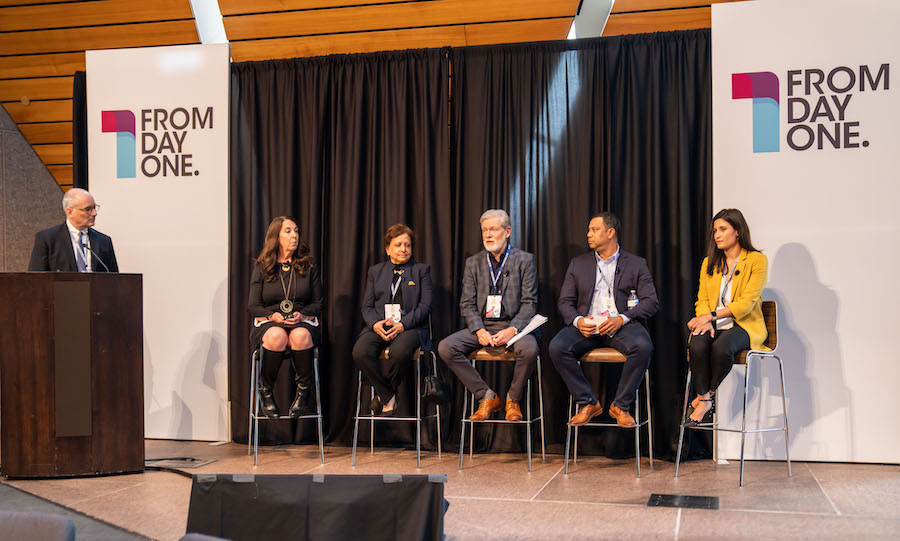Strengthening the Corporate Role in Revitalizing Underserved Communities


Even before the upheaval of the pandemic and the racial reckoning that followed George Floyd’s murder, businesses were seeking more ways to support and elevate marginalized communities in their midst.
Today, that work is regarded as ever more urgent. In companies big and small, HR professionals are harnessing novel ways to mobilize their workforces to foster meaningful change in challenged communities.
“The importance of corporate social responsibility has grown tenfold,” said Sofia Terzic, assistant vice president, community affairs manager at U.S. Bank, speaking as part of a May panel discussion at a From Day One conference in Minneapolis.
In the past five years, Terzic said that U.S. Bank has expanded company-wide programs that pay employees when they volunteer, match their financial contributions and considers their community engagement as part of their performance evaluations.
“We have a chief social responsibility officer who is part of our C suite. That shows employees, hey, this is super important to us as a corporation,” she added.
.jpg)
Millennial and Gen Z workers hold high expectations that their employers will tackle difficult societal problems. Srilata Zaheer, dean of the Carlson School of Management at the University of Minnesota, spends her days with college students pursuing careers in business. Part of their coursework requires them to participate in pro bono projects and partnerships with local non-profits.
“Engagement is key, especially with the next generation that really wants purpose in their companies. They're drawn to the mission,” Zaheer said.
A generational sea change is cresting, according to HR veteran Scott Peterson, executive vice president and chief human resources officer at the Schwan’s Food Company.
Peterson recalled an era in the not-too-distant past when expectations for giving were almost exclusively financial; employees filled out United Way donation cards and figured they’d done their civic duty.
“It's not just about money anymore, it's about money and minutes. Employees want to spend their time actually seeing the results of their efforts, making a difference in the communities in which they live,” he said. “I think it's been a healthy progression.”
Peterson explained that Schwan’s incentivizes employees to serve on nonprofit boards. Because board membership often comes with an expectation of an accompanying financial gift, Schwan’s matches their donation dollar-for-dollar.

But too many corporate dollars earmarked for philanthropy never go to worthy causes.
“Some recent research shows that there’s about $10 billion of unmatched matching funds that go unclaimed every year. Encourage your employees to really leverage those matching funds,” said Patty Healy Janssen, executive director of the Jeremiah Program, a nonprofit that uses education and stable housing to break the cycle of poverty for single moms.
“Not only does it incentivize employees, adding even more value, but it also really benefits the organization,” Janssen said.
Despite the volunteer hours, engagement and efforts, nonprofits still need money—and lots of it—to carry out their mission.
And that’s where today’s employees too often fall short, according to the Carlson School dean.
“I'll give you one statistic which is rather scary,” said Sri Zaheer. “Since 2014 at the Carlson School, we've seen a 74% drop in individual donations under $100. At the same time, we're raising tons of money, but it is fewer people giving larger amounts of money. Giving your time and talent, that's wonderful, we need that. But a lot of nonprofits also need the cash. We need to start building up that kind of giving mindset, even if it's $10, to get them into that practice of giving.”
Zaheer’s comment about the drop in small donations got the attention of the panel moderator, Minneapolis Star Tribune business columnist Evan Ramstad. He asked the professionals on the panel and in the audience if they, too, had noticed that employee giving had decreased in recent years and expressed surprise when about half of those in attendance put up their hands in agreement.
“Wow, fascinating. There's a column in this, I think,” Ramstad said as he surveyed the group.
Today, many of the social issues that volunteers tackle through their employer’s outreach—inequities in health and education, generational poverty, hunger and housing—are complex and stubborn.
That’s why companies need to take the long view in their philanthropic vision, according to Art Howard, vice president, global diversity, equity and inclusion for publishing company Wiley.
“One of the things that we've learned is that this work takes commitment and we're not going to see results right around the corner,” he said. “But if we stay committed to it and build the right partnerships, you have buy-in to moving the needle in the places that you're looking to move it.”
Kevyn Burger is an award winning broadcaster and freelance writer based in Minneapolis.
The From Day One Newsletter is a monthly roundup of articles, features, and editorials on innovative ways for companies to forge stronger relationships with their employees, customers, and communities.